TEC
Trains
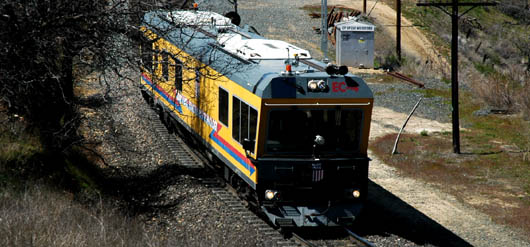
Union Pacific Track Evaluation Car number EC-4 works the
Tehachapi Loop in California, USA.
Track Evaluation Methods
Canada's two major railways have increased the frequency
of ultrasonic testing of their rail networks, particularly in the colder winter months when the number of rail defects
increases. Gauge restraint measuring is done by both railways to identify weak tie areas, and annual rail defect
testing programs have increased to three or more times per year. CN has contracted hi-rail test cars to
monitor gauge, cross-level, and alignment more frequently than regularly scheduled Test car runs.
The CPR Track Evaluation Car measures track geometry at frequencies defined in CPR's specification SPC 34. Urgent and
priority surface, elevation, alignment, cross-level, and gauge defects are identified and action is taken
as defined in the SPC. The Track Evaluation Car calculates a SRI (Surface Roughness Index), which is an average of the
number of surface-related defects per mile. Comparison of SRI values between runs gives an indication of
track condition over time. The lower the SRI number, the better the track.
The CN Test Car performs the same function and calculates a TQI (Track Quality Index), which represents the average
quality of each quarter-mile of track for surface, cross-level, gauge, and alignment. The
values range from 0 to 1,000 with 1,000 representing perfect track.
With increased traffic at higher speeds and heavier axle loads, rail inspection is more important than ever. Until the
early years of the last century, rail inspections for defects were performed solely visually, and were limited to
finding external defects only and sometimes the subtle signs of large internal problems.
Sperry Rail Service, which performs all rail testing on CN and CPR trackage under contract, started to develop an
induction method of testing rail for internal defects in the 1920s. The system involves creating a strong magnetic
field in the rail by passing a large amount of low-voltage current through it. The presence of an internal
defect changes the magnetic field and the defect indication is recorded on a strip chart. The induction method inspects
mainly the rail head, and although transverse fissures can be found, many other manufacturing,
service-related defects, and fatigue cracks below the rail head are not detectable.
To complement induction testing, ultrasonic NDT (Non-Destructive Testing) and inspection was developed
from early medical applications. Ultrasonic testing uses transducer-generated high-frequency
sound energy propagated through material in the form of waves. When there is a discontinuity such as a crack in the
wave path, part of the energy is reflected back from the flaw surface. The reflected wave signal is transformed into
an electrical signal by the transducer and is displayed on a screen. The reflected signal strength is displayed versus
the time from signal generation to when an echo was received. Signal travel time can be directly related to the
distance the signal travelled and accurate information about the reflector location, size, and orientation can
immediately be gained. North American railways have been inspecting rails using the ultrasonic method since the first
all-ultrasonic inspection car was introduced in 1959, and this is the most common method in use today.
Ultrasonics provide a fast, cost-effective, efficient, and productive way to test the thousands of miles
of rail in the North American rail network. Technological advances have made the process more accurate, information
processing faster, and have enhanced the visual presentation of the test results reducing the amount of human
interpretation/intervention required. The rail testing contract establishes performance specifications that specify
minimum-sized defects to be detected and reliability ratios. Railways measure performance by monitoring
in-service failures within 30 days of a rail test.
As with all NDT methods, ultrasonic inspection has its limitations. Transverse-oriented flaws are detected
in the head and upper web area. While the rail head receives a good test, the current technology does not allow
thorough inspection of the web and base. Mid-web and lower transverse flaws are almost impossible to
detect due to their orientation or location. Longitudinal flaws can be detected in the head and web sections as well
as in the base area below the web if they are large enough. Defects located in the outer area of the web (away from
the web towards the outer base area) cannot be detected because there is no ultrasonic signal transmitted into this
area of the rail.
Rail testing is not an exact science - skill, training, and experience are required to properly interpret test data
and identify rail defects. The cars usually operate with a driver, operator, and an assistant who is usually a trainee.
The driver is responsible for the safe operation of the car and the operator is responsible for the rail testing.
Ultrasonic operators are required to perform a number of tasks simultaneously while testing including monitoring the
six channels of test data as the car scrolls by, and the rail conditions and track features as the car moves. All this
is carried out while endeavouring to maximize daily test miles in an environment of reduced work windows. Defects must
be large enough, and oriented to present a reflective surface big enough to be detected. Deficiencies in any of these
areas can, and have resulted, in operator misinterpretation with defects not being properly identified or smaller
defects being missed.
Rail surfaces must be smooth and clean to accept and properly reflect the ultrasonic signal. Any condition that results
in the ultrasonic signal being reflected before reaching the expected location at the base or side of the rail will
result in a defect being suspected at that location. Such spurious reflections are most frequently caused by poor
surface condition or contamination of the rail surface. The operator must exercise good judgment to determine the
validity of an indication. The operator may erroneously conclude that a rail defect is present when in fact it is not
(false positive) or that an indication is spurious when in fact it is real (false negative).
The FRA (Federal Railroad Administration) and the AAR (Association of American Railroads) are sponsoring research into
improved rail flaw detection under AAR Strategic Research Initiative 7A. The objective is to improve the reliability
and safety of railway operations by developing improved flaw detection methods and fostering development of improved
flaw detection systems. Phased-array ultrasonics target higher reliability to detect defects 20 percent
in size or smaller. Laser-based ultrasonics provide the capability to inspect the entire rail section and
to inspect rail with poor surface conditions because the sound is not restricted to entering the rail from the top.
Small test units that can be lifted and operated by one person have been developed for single or two-rail
testing of crossings, switches, and frogs. These portable units can be used in yards without tying up a larger test
vehicle, and they reduce disruption to railway operations. Work continues to be directed at increased test speeds,
increased detection reliability through pattern recognition software, automation of operator
decision-making tasks, and enhanced sensor performance.
While rail defect testing reduces the risk of broken rail derailments, the detection of all internal rail defects is
not within the capacity of the systems currently in use - Transportation Safety Board of Canada.
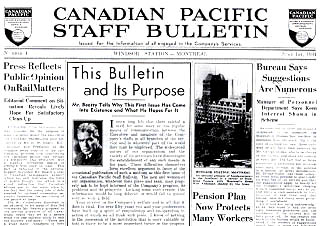
First CPR employee newspaper published in June 1934.
A Canadian Pacific employee magazine in newspaper format was started
in June 1934 as the "Canadian Pacific Staff Bulletin". It was "Issued for the information of all engaged
in the Company's Services". The format changed to a magazine in January 1944. The name changed to
"Spanner" in October 1947. The "Spanner" was retired in July 1971, and a new publication once
again in newspaper format, returned as "CP Rail News" began publishing in September 1971. By 2002 CP Rail
News was labeled Canadian Pacific Railway News when the following article about their TEC Train was printed in Volume
32 Number 2 on 2002.
CPR News Article of 2002
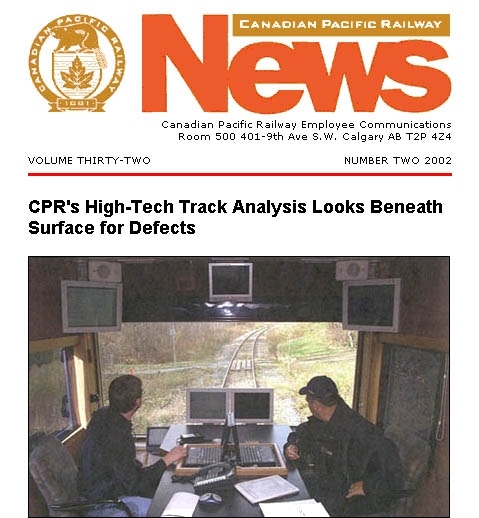
Greg Gormick
Correspondent
Toronto - Two track evaluation trains appear regularly, like
high-tech phantoms, all across the CPR system. But as is the case with much of the railway's
advanced equipment, they aren't all that well known, even within the company.
Self-contained
The rolling track laboratories were designed and built in-house by CPR engineering and mechanical
staff at a cost of $2.4 million per train. Each is self-contained and consists of three cars hauled
by a GP9 locomotive. On board, electrical power is provided by a generator car.
Another rail car provides a rolling home for the technicians who travel with the train for a week or more at a
time.
"Not only do we contribute to CPR safety, we also generate revenue by performing these evaluations for
other railways", said Ron Gagne, CPR manager of track evaluation and contract services.
Fully loaded
At the heart of each train is a track evaluation car which carries the sophisticated laser and computer equipment
that analyses and records all aspects of the track. Each of these cars was rebuilt from a former passenger car
with a lead floor, three to four inches thick, to simulate the forces that a fully-loaded freight
car exerts on the track. Large observation windows, and video cameras mounted on the front and sides of each
train, allow technicians to view and video tape all aspects of the track. Computers record and analyse all
details at speeds up to 60 mph.
It's an effort that contributes to the excellent record CPR has achieved in reducing the number of train
accidents to the lowest levels in the North American railway industry: 1.9 million train miles in
2001.
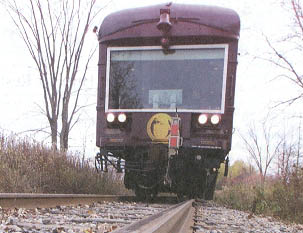
This Canadian Pacific
Railway News article is copyright 2002 by the Canadian Pacific Railway and is reprinted here with their
permission. All photographs, logos, and trademarks are the property of the Canadian Pacific Railway
Company.
|
Additional Photos
Recently some new photographs have come to light that give a better view of the interior and exterior of the CPR
"TEC Train" as it has become known. The actual technical details of how the track evaluation car functions
in service are not available to the public and may be a CPR proprietary secret but these photos show some of the
interesting equipment found inside.
| |
|
|
GP9u 8218 leads one of two CPR track evaluation trains as it
rolls eastward on the passing siding at Walsh, Alberta, mile 115.0 of the Maple Creek Subdivision. The two trains
roam the CPR system testing rail and roadbed for flaws, gauge anomalies, or other problems using the latest in
detection technology. The boxcar holds equipment and tools while Coach number 65 provides lodging for the testing
personnel. Track Evaluation Car 64 brings up the rear and is equipped with a bell, horn, headlights, and two sets
of ditch lights for back-up moves on branch lines where no turning facilities exist. GP9u's 8217 and
8218 are dedicated power for the two trains, being specially equipped with front-facing video
cameras and other power connections.
|
|
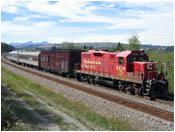 |
| |
|
|
A Canadian Pacific Railway TEC Train with Supply and Service
boxcar CP 424994, crew accommodation car CP 65, and Track Evaluation Car CP 64 work westbound on the Laggan
Subdivision. The train is shown between Lake Louise and Divide on the North Track of the Lake Louise grade
separation.
|
|
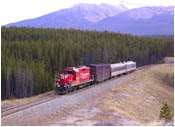 |
| |
|
|
A Canadian Pacific Railway TEC Train with Supply and Service
boxcar CP 424994, crew accommodation car CP 65, and Track Evaluation Car CP 64 work westbound on the Laggan
Subdivision. The train is shown between Lake Louise and Divide on the North Track of the Lake Louise grade
separation.
|
|
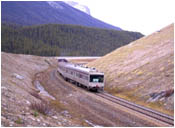 |
| |
|
|
Canadian Pacific's TEC Train supply and service boxcar CP
424994 in an earlier paint scheme. The location, date, and photographer is unknown.
|
|
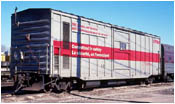 |
| |
|
|
The current paint scheme for CP 424994 as photographed at
Nanaimo on the Esquimalt & Nanaimo Railway in 2002.
|
|
 |
| |
|
|
TEC Train crew accommodation car CP 65 at an unknown location.
Date and photographer also unknown.
|
|
 |
| |
|
|
Canadian Pacific Railway Track Evaluation Car number 64 shown
at Welcox yard in Nanaimo after a day examining the Esquimalt & Nanaimo Railway.
|
|
 |
| |
|
|
Canadian Pacific Railway Track Evaluation Car number 64 shown
at Welcox yard in Nanaimo after a day examining the Esquimalt & Nanaimo Railway.
|
|
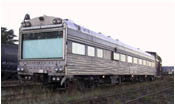 |
| |
|
|
The rear observation window of CP 64 while at Radnor Siding
on the Laggan Subdivision. Above the window the center TV screen shows the view from a camera mounted above the
bell on the locomotive while the screens on each side look down the side of the train.
|
|
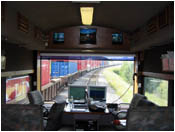 |
| |
|
|
This shot depicts the seating arrangement in the observation
room of CP 64 behind the rear facing window. The control room may be seen through the doorway.
|
|
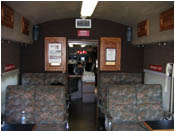 |
| |
|
|
The operators carry out their duties monitoring and assessing
the results of a track evaluation run here in the control room of CP 64.
|
|
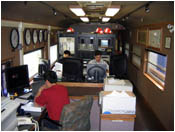 |
| |
|
|
Canadian Pacific's second Track Evaluation Car is number 63
shown here at St. Paul Minneapolis, USA.
|
|
 |
| |
|
|
This is the rear observation window on TEC 63.
|
|
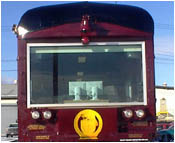 |
| |
|
|
Tim Stevens caught this photo of Canadian National's TEC Train
switching tracks in the yard at Jasper, Alberta, in the summer of 2007.
|
|
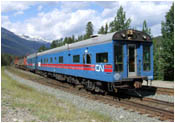 |
| |
|
|
Track Evaluation Car CN 15008 and support boxcar were also
photographed stored at a Jasper siding by Tim Stevens.
|
|
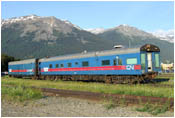 |
| |
|
|
Union Pacific Railroad EC-4 is their
self-powered Track Evaluation Car. In this photo it is working downgrade on the Tehachapi Loop in
California, USA.
|
|
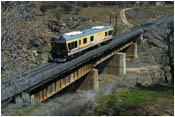 |
| |
|
|
Sperry is a world leading rail flaw detection company providing
rail flaw detection services using state-of-the-art proprietary systems and techniques of
ultrasonic and electromagnetic testing to discover flaws otherwise not detectable which could lead to rail
service failures or derailments. This vehicle is one of their 800/850/900 series hi-rail
vehicles.
|
|
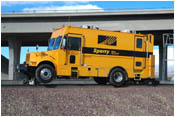 |
Associated Web Sites
Canadian Pacific Railway
Transportation Safety Board
of Canada
Wikipedia - Sperry Rail Service
Sperry Rail Service
The Un-Official Sperry Rail Service Web Site
Ensco Inc.
KLD Labs Inc.
Amberg
Technologies
MERMEC

|